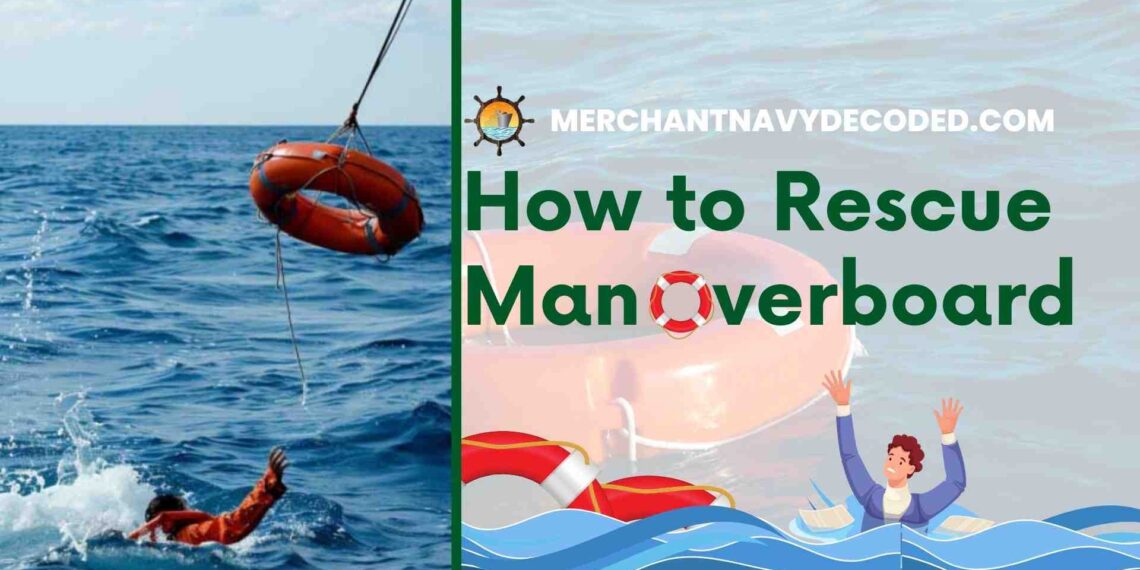What is Man Overboard on Ship & Action to be Taken in Case of MOB
Table of contents
- 1:- What is Man Overboard?
- 2:- Reasons for Man Overboard Situations
- 3:- Actions to Be Taken During a Man Overboard Situation
- 4:- Important Steps to be Taken After Man Overboard
- 5:- What is the Williamson Turn
- 6:- What is the Scharnow Turn
- 7:- What is the Anderson Turn
- 8:- Safety Measure to Avoid Man Overboard
- 9:- Conclusion
1:- What is Man Overboard?
A Man Overboard (MOB) situation occurs when someone on a ship accidentally falls into the sea. It can happen while at port or in the open ocean, and it’s a serious emergency. The individual is at risk of drowning or suffering from cold water shock or hypothermia, so immediate action is crucial to rescue them. To handle MOB emergencies effectively, regular drills and training are essential for every crew member.
2:- Reasons for Man Overboard Situations
Seafarers must exercise extreme caution while performing their duties, as the risk of falling overboard is always present. Several factors can lead to a man overboard scenario:
- Bad Weather: Strong winds and high seas can cause instability, making it easy for crew members to lose their balance and fall.
- Sea Swell: Sudden and powerful waves can unexpectedly sweep crew members off their feet and overboard.
- Accidents: Unforeseen incidents, such as slipping, tripping, or mishandling equipment, can result in someone falling into the sea.
- Negligence: Failure to follow safety protocols, such as not wearing a safety harness or not securing oneself properly, significantly increases the risk.
A “man overboard” situation is very dangerous, with risks like drowning in rough seas and hypothermia from cold water. Quick action is essential to rescue the person and ensure their safety. Training and safety protocols help save lives when someone falls overboard.
3:- Man Overboard Procedure
The immediate and early sighting of a fallen crew member significantly increases their chances of survival. The following actions must be taken to rescue the person who has fallen overboard:
- Alert the Crew: Shout “Man Overboard on Starboard/Portside.”
- Steer the Ship: Switch to hand steering from the auto and turn the wheel hard to the respective side.
- Deploy MOB Marker: Release the MOB marker from the bridge wing; this buoyant marker has a self-igniting light and self-activating smoke signal.
- Mark Position: Press the MOB button on the GPS to mark the casualty’s position.
- Sound Alarm: Sound three prolonged blasts on the whistle to alert the crew and supplement with the appropriate ‘O’ flag.
- Post Lookout: Assign an extra lookout immediately.
- General Alarm: Sound the General Alarm to alert all crew members.
- Announce MOB: Use the ship’s PA system to announce the MOB situation.
- Inform Engine Room: Notify the engine room that maneuvering will be required.
- Execute Williamson Turn: Perform the Williamson turn to return to the MOB’s position.
- Monitor Radar/ARPA: Keep a close watch on the radar and set VHF to Channel 16.
- Log Events: Record all events in the Bell book.
- Follow Master’s Orders: Execute commands from the Master.
- Deck Operations: The Chief Mate manages deck operations, including lowering survival craft.
- Bridge Assistance: The Third Mate assists the Master on the bridge.
- Urgency Signal: Send out an urgency signal to inform nearby ships.
- Visual Contact: Keep the lifebuoy marker in sight.
- Rescue Boat: Man the rescue boat adequately and ensure all crew wear personal location beacons. Carry a portable VHF radio.
- Rescue and Recovery: Once the person is rescued, retrieve the lifebuoy and hoist the rescue boat back.
- First Aid: Administer immediate first aid if required.
- Cancel MOB Alert: Send out a signal to cancel the previous MOB alert.
- Log Entries: Make appropriate entries in the Ship’s Logbook.
- Conduct Inquiry: The Master must conduct an inquiry and document the incident.
CLICK HERE to learn how you can save yourself in case of a man overboard situation.
4:- Important Steps to be Taken After Man Overboard
- Engine and Steering: The engines should not be stopped immediately to keep the person away from the propeller. Turning the wheel hard over helps keep the stern away from the casualty.
- Visibility Challenges: Sighting a person overboard can be difficult during daylight due to glare; immediate and coordinated action is crucial.
- Lifebuoy Utility: The lifebuoy’s smoke signal helps mark the MOB’s location. It should be retrieved to prevent confusion for other ships.
5:- What is the Williamson Turn

- The Williamson Turn is the most commonly used maneuver to recover a person overboard, especially when visibility is limited. It allows the ship to retrace its path to where the person fell.
- Initial Action: When a man overboard is reported, turn the ship’s rudder hard towards the side where the person fell. This ensures the vessel moves in the direction of the casualty immediately.
- Course Adjustment: Continue turning until the ship reaches a 60-degree course change from its original heading. Then, steer the rudder hard in the opposite direction. This sharp change of direction is crucial to initiating a reciprocal route, bringing the ship back to its original course.
- Completion: Once the ship has turned 180 degrees, the course will be aligned to track back to the casualty’s position. The reciprocal route allows the ship to come back along the same path, increasing the likelihood of spotting the person overboard.
- The Williamson Turn is ideal for nighttime recoveries or situations where the exact position of the casualty is uncertain.
6:- What is the Scharnow Turn
- The Scharnow Turn is another method for recovering someone overboard, but it is typically used when the casualty is already astern, and the ship has travelled a considerable distance before the incident is reported. This maneuver is quicker than the Williamson Turn in terms of turning back to the point of the fall.
- Large Turn: When the person falls overboard, steer the rudder hard towards the casualty and continue turning until the ship completes a 240-degree turn. This allows the ship to begin retracing its course quickly.
- Opposite Turn: After the large turn is complete, turn the rudder hard in the opposite direction to adjust the course back.
- Completion: Finally, align the ship back to the reciprocal course, returning you to the location of the incident. This maneuver is suitable when visibility is good and the ship has sufficient space to complete the wide turn.
- The Scharnow Turn is highly effective for fast ships with large turning radii, ensuring quick response times and a smooth approach to the casualty.
7:- What is the Anderson Turn

- The Round Turn or Anderson Turn is the fastest maneuver for recovering a person overboard. This technique is particularly useful when the casualty’s position is visible and immediate action is required.
- Immediate Stop: The moment a person falls overboard, the engines are stopped, and the ship’s rudder is turned towards the casualty. This ensures the ship begins to turn toward the person while quickly slowing down.
- Resuming Speed: Once the casualty is cleared, the engines can be resumed to maintain speed, but the turn is continued until the ship has achieved a 240-degree course change. This keeps the ship on track to quickly return to the casualty’s position.
- The Anderson Turn is preferred in calm conditions and when the person overboard is visible at all times. It requires skill and precise execution, but it is the fastest recovery method when time is critical.
8:- Safety Measure to Avoid Man Overboard
Preventing Man Overboard (MOB) incidents requires a combination of safety measures, proper training, and vigilance. Here are key strategies to minimize the risk:
- Crew Training and Drills: Regularly train and drill all crew members on man overboard procedures, including how to use safety equipment and perform rescue operations.
- Safety Equipment: Ensure that all crew and passengers wear appropriate personal flotation devices (PFDs) and that life rings, life buoys, and other rescue equipment are easily accessible and in good condition.
- Effective Communication: Maintain clear communication among crew members, especially when performing tasks near the edge of the vessel or during rough conditions.
- Safety Barriers and Guardrails: Install and regularly inspect safety barriers, guardrails, and non-slip surfaces around the deck to prevent accidental falls.
- Watchkeeping Procedures: Implement strict watchkeeping procedures to ensure that the crew is alert and monitoring all areas of the vessel, particularly in high-risk conditions or during challenging maneuvers.
- Regular Equipment Maintenance: Perform routine checks and maintenance on all safety equipment and systems to ensure they are operational and ready for use in an emergency.
- Risk Assessment: Conduct risk assessments for various operations and conditions to identify potential hazards and implement preventive measures.
9:- Conclusion
Man overboard situations are critical emergencies that require swift action to prevent loss of life. Whether due to bad weather, sea swell, accidents, or negligence, crew members falling into the sea pose significant risks.
We discussed various maritime maneuvers used to rescue people who have gone overboard, with a focus on the Williamson Turn, Scharnow Turn, and Anderson Turn. Each maneuver outlines specific methods for changing course and controlling the ship’s rudder and engines to effectively return to the casualty.
10:- Frequently Asked Questions Regarding Man Overboard (MOB)
The very first thing you should do is shout “Man Overboard” as loud as you can and alert the rest of the crew.
The Williamson Turn is popular because it allows the ship to quickly return to the location of the overboard person while minimizing the risk of losing sight of them.
Personal flotation devices (PFDs), life rings, harnesses, and safety barriers are all crucial.
Strong winds, heavy seas, and sudden waves can cause crew members to lose their balance, slip, or be knocked overboard. In bad weather, extra precautions should be taken, and the crew must always wear safety harnesses.
Survival time varies depending on water temperature, weather conditions, and the individual’s health, but hypothermia can set in within minutes in cold water.
Disclaimer :- The opinions expressed in this article belong solely to the author and may not necessarily reflect those of Merchant Navy Decoded. We cannot guarantee the accuracy of the information provided and disclaim any responsibility for it. Data and visuals used are sourced from publicly available information and may not be authenticated by any regulatory body. Reviews and comments appearing on our blogs represent the opinions of individuals and do not necessarily reflect the views of Merchant Navy Decoded. We are not responsible for any loss or damage resulting from reliance on these reviews or comments.
Reproduction, copying, sharing, or use of the article or images in any form is strictly prohibited without prior permission from both the author and Merchant Navy Decoded.


